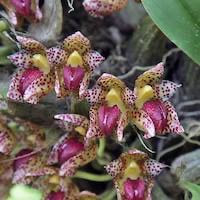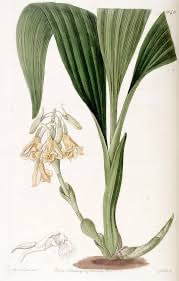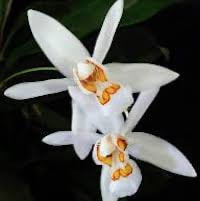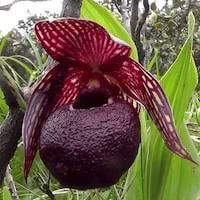WFR8- Women's Fresh 8 - Under the waterfall
|
Native Singaporean Orchid notes: Anoectochilus formosanus Hayata
Anoectochilus formosanus Hayata, also known as the gold thread orchid, thrives naturally in Taiwan's ancient forests and bamboo groves, as well as in the Ryukyu Islands. In Traditional Chinese Medicine (TCM), the whole plant is prized for its cooling properties, liver-smoothing effects, and detoxification abilities. It's used to treat a range of ailments including tuberculosis, diabetes, bronchitis, kidney infections, and snake bites. Scientists have identified several beneficial compounds in this orchid, such as quercetin-7-o-beta-D-(600-o-(trans-feruloyl))-glucopyranoside and kinsenoside, which contribute to its therapeutic properties, including hepatoprotection. These compounds also enhance the orchid's fragrance profile and potential use in aromatherapy and medicinal applications.
|
Therapeutic Orchid notes:
|
Bulbophyllum leopardinum
Bulbophyllum leopardinum, known as Duantingshiduo Lan in Chinese, is a widespread orchid found in Nepal, Bhutan, India, and China. In Nepal, it is valued for its medicinal benefits, particularly in treating burns. The pseudobulbs of this orchid are used to make poultices applied directly to the skin to aid in burn recovery. Bulbophyllum leopardinum contains active compounds like phenenthrine and bulbophyllanthrin, which are believed to contribute to its healing properties for skin burns. |
|
Calanthe densiflora Lindl.
Calanthe densiflora Lindl., known as Zhuyegenjie Lan or Mihuaxiaji Lan in Chinese, is a terrestrial herb found in shaded hardwood forests across the southern Himalayas, China, Indochina, and Japan. In Taiwan, it grows below 1500 meters and blooms from October to December. In Taiwanese Chinese herbal medicine, the entire plant of Calanthe densiflora is used for its medicinal properties. It is believed to enhance blood circulation, reduce blood stasis, and relieve swelling, gas, and dampness. This herb is commonly used to treat ailments such as rheumatism, back pain, lower limb pain, ulcers, and injuries. |
|
Coelogyne corymbosa Lindl. syn Pleione corymbosa (Lindl) Kuntze
Coelogyne corymbosa Lindl., also known as Yanbanbeimu Lan, Beimu Lan, Zhixueguo, Shibajiao, Duiyeguo, and Xiaoluji in Chinese, is a medicinal herb collected from Yunnan and Xizang. It is used year-round, primarily for treating fractures and soft tissue injuries due to its hemostatic and pain-relieving properties. In Chinese medicine, it's also utilized to cool the body, alleviate heat-related conditions like coughs, flu, and bronchitis. Different parts of the plant are employed depending on the ailment: the whole plant for bronchitis, sheaths for injuries, and a specific mixture for fractures with additional wound care protocols. |
|
Cypripedium tibeticum King ex Rolfe syn. Cypripedium corrugatum Franch.
Cypripedium tibeticum, also known as Tibetan scoop orchid or Xizang Zhuolan in Chinese, is valued for its medicinal roots collected mainly from Yunnan. In Chinese medicine, it's called Zhoushao Lan or crepe spoon orchid and blooms from May to August in open forests and rocky slopes. Its roots are used for their anti-inflammatory and pain-relieving properties, enhancing urine output, improving circulation, and treating menstrual disorders. Historically, Cypripedium species globally have been used in Western, Native American, and Indian medicines for various nervous system issues and malaria treatment, reflecting its broad therapeutic potential. |
Other scent note
Cactus, Ivy, Tobacco leaf, Sage, Vine, Tobacco, Ginkgo, Violet leaf, Juniper, Wintergreen, Lemongrass, Eucalyptus
Scentopia Library Reference ingredient
Fennel- Check details at Scentopia's scent library
Download the guided mediation that works best with this Orchid fragrance oil
| women_fresh_essential_oil_orchi_00008.mp3 | |
| File Size: | 154709 kb |
| File Type: | mp3 |




